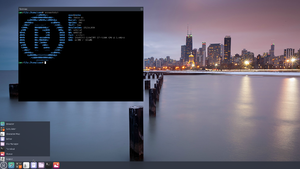
In computing, the Executable and Linkable Format is a common standard file format for executable files, object code, shared libraries, and core dumps. First published in the specification for the application binary interface (ABI) of the Unix operating system version named System V Release 4 (SVR4), and later in the Tool Interface Standard, it was quickly accepted among different vendors of Unix systems. In 1999, it was chosen as the standard binary file format for Unix and Unix-like systems on x86 processors by the 86open project.
Windows is a product line of proprietary graphical operating systems developed and marketed by Microsoft. It is grouped into families and subfamilies that cater to particular sectors of the computing industry – Windows (unqualified) for a consumer or corporate workstation, Windows Server for a server and Windows IoT for an embedded system. Windows is sold as either a consumer retail product or licensed to third-party hardware manufacturers who sell products bundled with Windows.

Wine is a free and open-source compatibility layer to allow application software and computer games developed for Microsoft Windows to run on Unix-like operating systems. Developers can compile Windows applications against WineLib to help port them to Unix-like systems. Wine is predominantly written using black-box testing reverse-engineering, to avoid copyright issues. No code emulation or virtualization occurs. Wine is primarily developed for Linux and macOS.
Darwin is the core Unix-like operating system of macOS, iOS, watchOS, tvOS, iPadOS, audioOS, visionOS, and bridgeOS. It previously existed as an independent open-source operating system, first released by Apple Inc. in 2000. It is composed of code derived from NeXTSTEP, FreeBSD, other BSD operating systems, Mach, and other free software projects' code, as well as code developed by Apple. Darwin's official mascot is Hexley the Platypus.

XNU is the computer operating system (OS) kernel developed at Apple Inc. since December 1996 for use in the Mac OS X operating system and released as free and open-source software as part of the Darwin OS, which, in addition to being the basis for macOS, is also the basis for Apple TV Software, iOS, iPadOS, watchOS, visionOS, and tvOS.

Unified Extensible Firmware Interface is a specification for the firmware architecture of a computing platform. When a computer is powered on, the UEFI-implementation is typically the first that runs, before starting the operating system. Examples include AMI Aptio, Phoenix SecureCore, TianoCore EDK II, InsydeH2O.

Git is a distributed version control system that tracks versions of files. It is often used to control source code by programmers who are developing software collaboratively.
In software development, distributed version control is a form of version control in which the complete codebase, including its full history, is mirrored on every developer's computer. Compared to centralized version control, this enables automatic management branching and merging, speeds up most operations, improves the ability to work offline, and does not rely on a single location for backups. Git, the world's most popular version control system, is a distributed version control system.
seccomp is a computer security facility in the Linux kernel. seccomp allows a process to make a one-way transition into a "secure" state where it cannot make any system calls except exit , sigreturn , read and write to already-open file descriptors. Should it attempt any other system calls, the kernel will either just log the event or terminate the process with SIGKILL or SIGSYS. In this sense, it does not virtualize the system's resources but isolates the process from them entirely.

Mercurial is a distributed revision control tool for software developers. It is supported on Microsoft Windows, Linux, and other Unix-like systems, such as FreeBSD and macOS.

The Embeddable Linux Kernel Subset (ELKS), formerly known as Linux-8086, is a Linux-like operating system kernel. It is a subset of the Linux kernel, intended for 16-bit computers with limited processor and memory resources such as machines powered by Intel 8086 and compatible microprocessors not supported by 32-bit Linux.

Kernel-based Virtual Machine (KVM) is a free and open-source virtualization module in the Linux kernel that allows the kernel to function as a hypervisor. It was merged into the mainline Linux kernel in version 2.6.20, which was released on February 5, 2007. KVM requires a processor with hardware virtualization extensions, such as Intel VT or AMD-V. KVM has also been ported to other operating systems such as FreeBSD and illumos in the form of loadable kernel modules.
Nix is a cross-platform package manager for Unix-like systems, and a tool to instantiate and manage those systems, invented in 2003 by Eelco Dolstra.

PicoLisp is a programming language, a dialect of the language Lisp. It runs on operating systems including Linux and others that are Portable Operating System Interface (POSIX) compliant. Its most prominent features are simplicity and minimalism. It is built on one internal data type: a cell. On the language level, a programmer can use three different data types being represented by cells and differentiated by bits at the end of the cell. It is free and open-source software released under an MIT License (X11).

Illumos is a partly free and open-source Unix operating system. It has been developed since 2010 and is based on OpenSolaris, after the discontinuation of that product by Oracle. It comprises a kernel, device drivers, system libraries, and utility software for system administration. Its core has become the base for many different open-sourced Illumos distributions, in a way similar to how the Linux kernel is used in different Linux distributions.
OpenWrt is an open-source project for embedded operating systems based on Linux, primarily used on embedded devices to route network traffic. The main components are Linux, util-linux, musl, and BusyBox. All components have been optimized to be small enough to fit into the limited storage and memory available in home routers.

mpv is free and open-source media player software based on MPlayer, mplayer2 and FFmpeg. It runs on several operating systems, including Unix-like operating systems and Microsoft Windows, along with having an Android port called mpv-android. It is cross-platform, running on ARM, MIPS, PowerPC, RISC-V, s390x, x86/IA-32, x86-64, and some other by 3rd party.

Fuchsia is an open-source capability-based operating system developed by Google. In contrast to Google's Linux-based operating systems such as ChromeOS and Android, Fuchsia is based on a custom kernel named Zircon. It publicly debuted as a self-hosted git repository in August 2016 without any official corporate announcement. After years of development, its official product launch was in 2021 on the first-generation Google Nest Hub, replacing its original Linux-based Cast OS.
Microsoft, a tech company historically known for its opposition to the open source software paradigm, turned to embrace the approach in the 2010s. From the 1970s through 2000s under CEOs Bill Gates and Steve Ballmer, Microsoft viewed the community creation and sharing of communal code, later to be known as free and open source software, as a threat to its business, and both executives spoke negatively against it. In the 2010s, as the industry turned towards cloud, embedded, and mobile computing—technologies powered by open source advances—CEO Satya Nadella led Microsoft towards open source adoption although Microsoft's traditional Windows business continued to grow throughout this period generating revenues of 26.8 billion in the third quarter of 2018, while Microsoft's Azure cloud revenues nearly doubled.
Tock is a free and open source embedded operating system for microcontrollers written in Rust. The operating system's goal is to isolate components so untrusted third-party applications can run on Cortex-M, RISC-V, and x86 processors in a protected environment.













